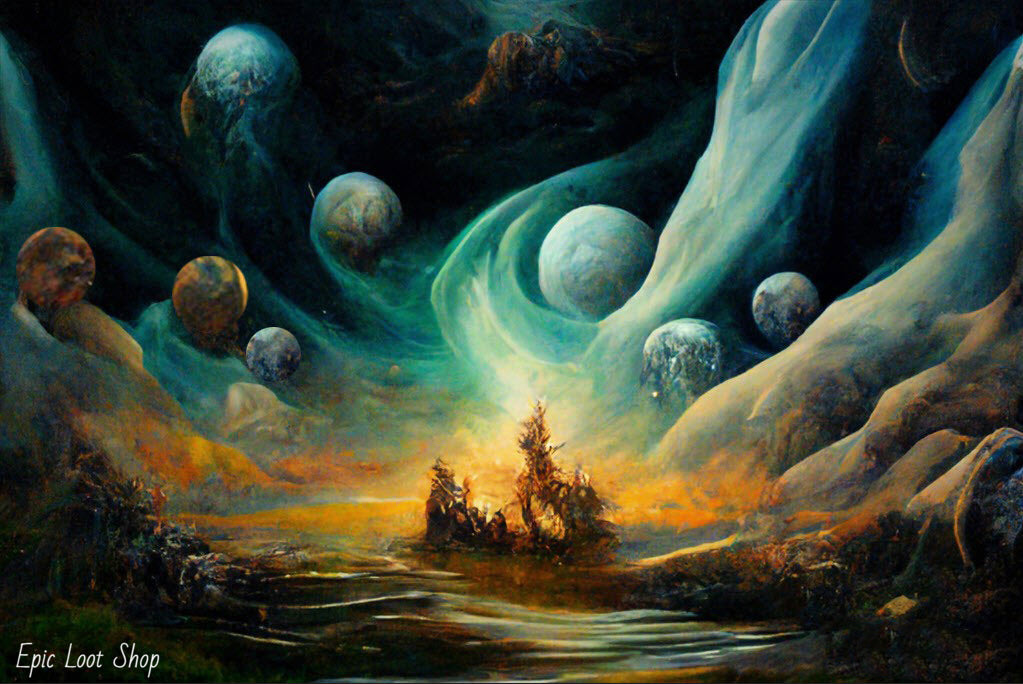The Nine Realms Of Norse Mythology
This blog post about the nine worlds of Norse mythology is going to be just perfect for you if you're a fan of Norse mythology. The set of myths that originated in Norse religion and were passed down through the North Germanic people is known as Norse mythology. The Poetic Edda and the Prose Edda are where you'll find the majority of the primary sources. We will investigate nine distinct worlds, each of which will include a discussion of the events taking place there, as well as key characters, locations, and objects.
What are the 9 realms name?
The Nine Realms are as follows:
1. Asgård (Ásgarðr) - the abode of the gods
2. Vanaheim (Vanaheimr) - home of the Vanir
3. Alfheim (Alfheimr) - where live the Light Elves
4. Svartálfaheim (Svartálfaheimr) - land of the Dark Elves
5. Jötunheim (Jötunheimr) - land of Giants
6. Niflheim (Niflhel) - the realm of ice and cold
7. Muspellsheim (Múspellsheimr) - land of fire and heat
8. Nidavellir (Niðavellir) - the Dwarf Kingdom
9. Midgard (Miðgarðr or Middangeard) - humans' world
Let's dive deeper into the realms
Asgård is the home of the Gods. It is a place that is mostly inhabited by divine beings such as gods, demigods, and giants. The Gods live in Asgard, which is a walled city with nine gates. The Gods also spend much of their time in Valhalla, where they eat and drink and prepare for Ragnarok (the end of the universe).
Vanaheim is located in the north and it's not considered one of the better worlds to live in. It's cold and snowy there and most plants don't grow well. The only thing that grows well are apples, which are considered sacred by the Vanir. They have to be picked at certain times or they won't grow properly.
Alfheim is a realm with many different types of creatures. The Valkyries are one group that lives there. They are women who ride horses through the air and guide those who have died in battle to Valhalla. There are also many other types of creatures like elves and dwarves that live in Alfheim, but these are some of the most important ones for our story.
Svartálfaheim is described as a dark, gloomy world where the temperature is always cold and never rises above freezing point. The rivers and lakes are filled with ice water that flows sluggishly through the land, making it difficult for any creatures to live there. The scenery is bleak and barren, with only small patches of snow-covered ground here and there.
Jötunheim (YOT-un-haym) is the far northern region of Niflheim, and is the homeland of the giants. It is a vast, cold wasteland that stretches across the northernmost regions of Niflheim. The land itself is barren, with little vegetation. The landscape is rocky and mountainous, with numerous volcanoes erupting constantly.
Niflheim is home to the dead who are not worthy of going to Valhalla or Fólkvangr. They are sent to Niflheimr rather than Hel's hall, Hvergelmir, because they were not good enough for Valhalla but not evil enough for Hel's hall.
Muspellsheim is described as a land of fire and ice. Its name means "world of Muspell," who is a god associated with fire; this association may be due to the fact that Muspell's wife Sól (the Sun) lives in this world. It is also known as "The Land of Flame."
Nidavellir is a dwarf world created by the Dwarves to help them manufacture their weapons and armor. In addition to being an important place of industry, Nidavellir is also home to many Dwarves and other creatures.
Midgard is the world of humans, located in the middle of Yggdrasil, the World Tree. It is populated by humans, dwarves, elves and other races. Midgard is also known as "Middle Earth" because it's the world where most people live out their lives.
Are the 9 realms universes?
The Nine Realms are not universes.
The Nine Realms are physically connected to each other and to the rest of the universe. All of them are located in a dimension that exists on top of the Multiverse, which is the same as our own universe.
The realms are connected through portals, which allow travel between them. These portals are usually created by powerful beings such as Odin or Loki, but they can sometimes be found in random places.
The Nine Realms have existed for thousands of years and were created by Yggdrasil, who is an ancient tree that sits at their center. It's unclear if Yggdrasil came before or after the realms themselves, but it's possible that it was created along with them and is part of their creation mythology.
Why did Odin stop at 9 realms?
The reason Odin stopped at 9 realms is because that was all he needed. He could have traveled further and discovered more, but he didn't want to.
Odin was a god who liked to be in control and he wanted control over everything. He wanted to be able to see everything that was going on in his kingdom. That's why he traveled around these 9 worlds and made sure they were running smoothly so that no problems would arise that would jeopardize his plans for Ragnarok.
Is Asgard and Valhalla the same?
Asgard and Valhalla are two worlds that are part of Norse mythology. Asgard is a world inhabited by the gods while Valhalla is a hall where they live and enjoy themselves.
Valhalla was built by Odin for himself and his warriors so that they could prepare for Ragnarok, when they would fight against Jormungandr (the serpent) and Surtur (the fire giant). Odin's Valkyrie wife Freya chose those warriors who would go to Valhalla to battle in Ragnarok because they had died bravely in battle.
Is there a 10th realm in Norse mythology?
A tenth realm is mentioned in Norse mythology, but it is not a physical place. Instead, the tenth realm is thought to be the afterlife.
The idea of a tenth realm came from an interpretation of the Poetic Edda, an ancient collection of poems that were written down in the 13th century. The poem "Grímnismál" mentions nine worlds in Asgard, which are located above the Earth and below Midgard.
The tenth realm was called "Hel," which means "unhappy" or "unlucky." Hel was ruled by a goddess named Hela and was considered to be a place where those who were evil went after they died.
Hel was described as being cold and dark, with no sun or moon shining on it. It had many gates that led into it from other places on Earth, such as through burial mounds or caves. The souls of those who entered Hel would also remain there forever and never return to their homes in this world again.
Conclusion
In conclusion, the nine realms that exist in Norse mythology are Midgard, Vanaheim, Asgard, Alfheim, Jotunheim, Svartalfheim, Nidavellir , Niflheim, and Muspelheim. Each of these worlds is intricately detailed and holds its own unique set of events and parameters. Regardless of which world we're talking about, they all possess a sense of wonder and magic that has proven to be irresistible to those who hold an interest in Norse mythology.




Leave a comment